The National Ballet of Canada brings Christopher Wheeldon’s Alice’s Adventures in Wonderland to Lincoln Center.
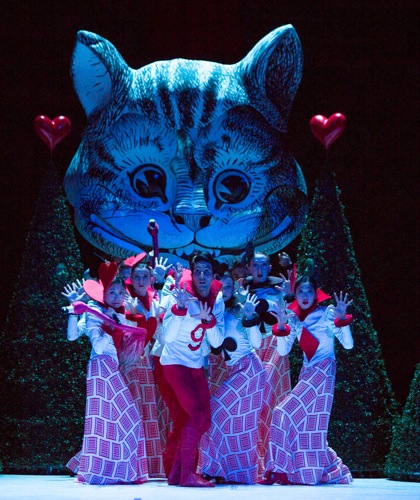
Lewis Carroll’s Cheshire Cat looms over a pack of cards in Christopher Wheeldon’s Alice’s Adventures in Wonderland. Photo: Yi-Chun Wu
“What did you like best, dear?” Were I a child who’d been taken to see the National Ballet of Canada perform Christopher Wheeldon’s Alice’s Adventures in Wonderland at Lincoln Center, I know what I’d answer: “the Cheshire Cat.” The CC is not just a huge, grinning, tiger-striped head; it has a body, four matching legs, and a tail. Each of its components is handled by a black-clad dancer as “invisible” as a Japanese bunraku puppeteer. The animal can fly apart and come together in highly satisfying ways. Had Alice viewed it in Act III instead of in Act II, after she had nibbled on the Caterpillar’s mushroom and embarked on her own discombobulated dance, we would have believed even more that Wheeldon and scenarist Nicholas Wright were stirring a bit of Woodstock into Lewis Carroll’s classic 1865 tale of a little girl’s dream.
Of course, there are many other elements to relish in Wheeldon’s Alice, which was premiered in 2011 by its co-commissioners, London’s Royal Ballet (where Wheeldon began his dancing career) in February of that year and the National Ballet of Canada in June. The Canadian company, co-sponsored by the Joyce Theater Foundation, presented it in New York for the first time this September. Running for two hours and forty-five minutes, the three-act story ballet abounds in spectacular visual designs and special effects by Jon Driscoll and Gemma Cunningham, as well as fine lighting by Natasha Katz and a marvelous sound score by Joby Talbot that conveys all the lurching transitions, magical environments, and eccentric adventures of the story. Wheeldon’s choreography, never less than skillful, has some splendidly inventive passages of dancing—especially fine in Act III.
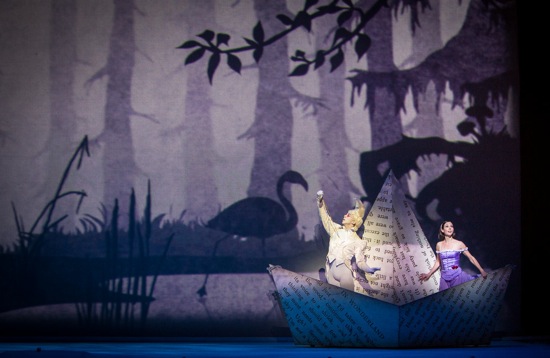
As in The Sleeping Beauty, Alice (Jillian Vanstone) and the White Rabbit (Dylan Tedaldi) “travel” through a moving panorama. Photo: Yi-Chun Wu
The ballet cost nearly two million dollars to produce, and nine tractor-trailers are needed to carry its sets. In an interview that appeared in the New York Times, Wheeldon explained to Marina Harss that, “I wanted to create a spectacular, like a big Broadway musical without words.” In this, he succeeded—spicing it also with magic-show illusions and vaudeville stunts—although I suspect that an old Broadway hand would prune here and there and bring out certain dramatic points more clearly. Some plot elements are extremely hard to get across without words; for instance, Carroll wrote the Caucus Race as a muddle, and so it is in the ballet, but movement alone can’t clearly convey the idea that resourceful Alice is trying to help a bunch of animals who’ve been soaked in the lake of her tears (when she was temporarily a giant) get warm and dry.
Carroll’s Alice rarely gives up or gives in. Pointing that up is perhaps the only way that a ballet can attempt to convey one of the book’s principal charms: little Alice’s remarkable resilience and fortitude: “‘The first thing I’ve got to do,’ said Alice to herself as she wandered about in the wood, ‘is to grow to my right size again; and the second thing is to find my way into that lovely garden. I think that will be the best plan.’”
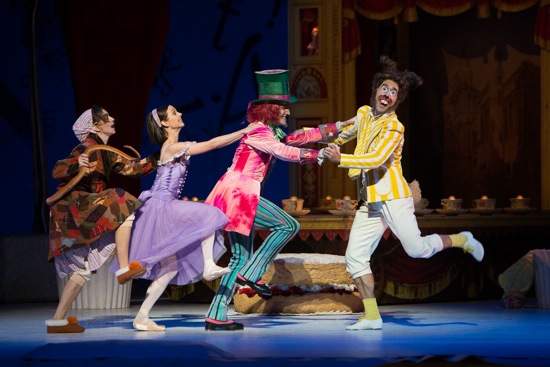
The tea party with the ballet’s opening night cast (L to R): The Dormouse (Tiffany Mosher), Alice (Jillian Vanstone), The Mad Hatter ( Robert Stephen), The March Hare (Jonathan Renna). Photo: Yi-Chun Wu
Ballets being what they are, Wheeldon couldn’t be that wittily succinct. Too, he and Talbot needed a romance—i.e. some pas de deux. The person for whom Carroll invented the story, Alice Liddell, was a fetching little girl when Carroll came to photograph the Dean of Christ Church, Oxford, and and became a friend to Dean Liddell’s entire family. The eponymous Alice of the ballet had to become a teen-ager. In addition, the collaborators invented a prologue in which all the principal characters that the book’s heroine meets in her dream come to a garden party at the Deanery in their real-world guises. The caterpillar shows up as a turbaned East Indian with female followers (wearing attire highly improper for such a gathering); the Mad Hatter is a hired magician; the March Hare and the Dormouse are the church’s vicar and verger; Carroll, on hand with his camera to photograph the occasion, becomes the White Rabbit (Robert Stephen, in the cast I saw, was excellent at all the twitchy bustling around that he had to do).
Stretching credibility slightly, Mrs. Liddell is very severe, since the dancer (Svetlana Lunkina, in this cast) also plays the Queen of Hearts, whose perpetual “off with his head!” responses to minor problems make her a major villain; escaping from her henchmen becomes a priority in the succeeding acts. Jack, the gardener’s boy, who has been invented as a possible boyfriend for Alice (and doubles as the Knave of Hearts), is summarily fired by the mistress of the house for stealing a tart, and, as the Knave, eventually saved from a beheading in Act III for the same felony, although in the ballet’s first scene, Alice snitched it to give to Jack. (If you think this sounds complicated, best you don’t read Wright’s lengthy program scenario.)
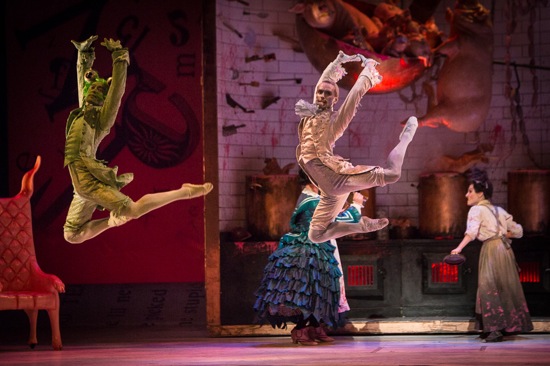
(L) The Frog-Footman (Keiichi Hirano) and The Fish-Footman ( Skylar Campbell) grace the nightmare kitchen. At back: the Duchess (Piotr Stanczyk) and the Cook ( Rebekah Rimsay). Photo: Yi-Chun Wu
When the ballet premiered, some of the criticism directed at it apparently mentioned that there wasn’t enough dancing in it. I beg to differ. The performers have considerable acting and pantomiming to do, but dancing pops up everywhere—whether it’s Jack Bertinshaw as the Mad Hatter executing a tap dance at the tea party into which Alice stumbles, or a clever-footed duet (lots of beating the legs together) for the Frog-Footman (Francesco Gabriele Frola) and the Fish-Footman (Dylan Tedaldi), or fine ensemble dances for flowers and playing cards. As Alice, Sonia Rodriguez might as well have been running a marathon in terms of energy expenditure. She not only acted boldly and convincingly, she rarely left the stage and danced beautifully in her own expressive solos and in her duets with the Knave (Naoya Ebe, another excellent and expressive dancer).
Wheeldon, who performed with both the Royal Ballet and the New York City Ballet and learned from George Balanchine and Jerome Robbins as well as from Frederick Ashton, seems to me in Alice to be working in a slightly Ashtonian style. There’s a great deal of delicate, excitable pointework and steps very subtly deranged from strict classicism in order to convey changeability. Passages of jumping are not presented with bravura, but with a springy energy (as befits, say a frog and a fish with ballet training) A bit of reticence clings to the nervy Alice. One step keeps catching my eye: instead of extending her leg from bent to straight in a developpé, she more often lifts it straight and then bends it into a passé and brings it down to a narrow, feet-together stance before moving on. The effect is one of a certain propriety, a slight withholding.
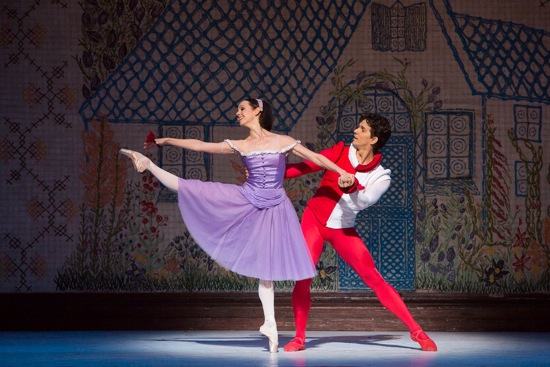
Jillian Vanstone as Alice and Guillaume Coté as the Knave of Heats in the opening night cast of Christopher Wheeldon’s Alice’s Adventures in Wonderland. Photo: Yi-Chun Wu
Without the dancing, the stage effects would go for naught, but there’s no denying that they are memorable. Alice doesn’t follow the White Rabbit down his hole. He (transitioning from Carroll to the fairytale guide) upends her into a giant molded pudding, after which a vertiginous black-and-white projection takes over the stage, and we see a puppet Alice in a downward spiral of tumbling letters of the alphabet. She’s been dropped into the book. A cramped and askew little room, also black-and-white, envelops her briefly to let us know the results of drinking from the bottle that says “Drink Me.” She’s also too big to get more than her head and shoulders through a tiny house that has been pulled onstage; beyond it, toward us, she sees the garden she’d like to get into, and the ensemble, dressed as flowers, whips down the suddenly lit aisle of the theater and then just as quickly exits again. Alice’s tears become rows of cardboard ocean waves (reminiscent of 19th-century scenery), between which hapless characters “swim” and are tossed.
Along the way, Wheeldon and his colleagues make numerous jokes. The Caterpillar (Harrison James) parades across the front of the stage equipped with a lengthy body beneath which we see a perfectly in-synch line of little dancerly feet wearing pointe shoes. Although the cottage Alice enters is announced by a giant sampler with “Home Sweet Home” stitched across it, the kitchen scene within looks like something you would encounter in Sweeney Todd: the Demon Barber of Fleet Street. Who knows what went into those sausages that the ferocious and frazzled Cook is making? (A terrific performance in this role by Stephanie Hutchison, who stomps around even more dangerously than did Helena Bonham Carter in the Sweeney Todd film). One puzzle, though: it didn’t seem to me that the Duchess (Jonathan Rena) had as much to do as I gather Simon Russell Beale (!) managed in the 2011 London production, nor was it clear that the wailing baby turned into a pig.
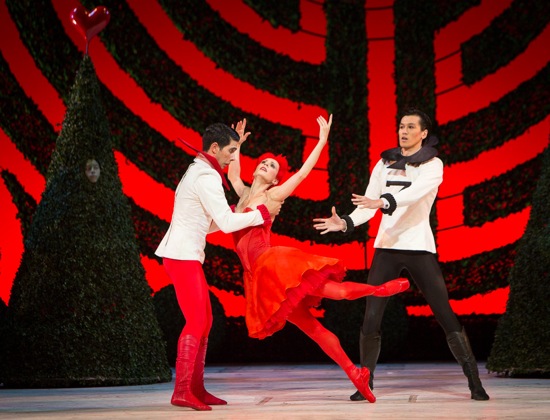
The Queen of Hearts (Greta Hodgkinson) and two of her beleaguered partners assail Christopher Wheeldon’s parody of the Rose Adagio. Photo: Yi-Chun Wu
The most hilarious passage is one in which Wheeldon has the Queen of Hearts step down from the giant, wheelable skirt that encases her, bow simperingly to the audience, whip off a cartwheel, and attempt a cockeyed version of the famed Rose Adagio from The Sleeping Beauty. In this, she is almost never securely in plumb and on balance, and her four supporting “princes” are cards from the pack, each of whom is so sure that he will be beheaded if he makes a mistake that mistakes are inevitable—such as being uncertain whether he should help the Queen up from the splits into which she has sunken with vaudevillian glee (Lunkina is a stellar comedian as well as an expert dancer).
The members of the National Ballet of Canada perform their roles with gusto—excellently skilled in their dancing and vivid in their acting. The wrap-up image is a bit pat, although I don’t know what a better one would be. Alice and Jack reappear as modern-day lovers visiting the Deanery garden, and Lewis Carroll/White Rabbit becomes a tourist, snapping photos to send home. Close the book, check YouTube.

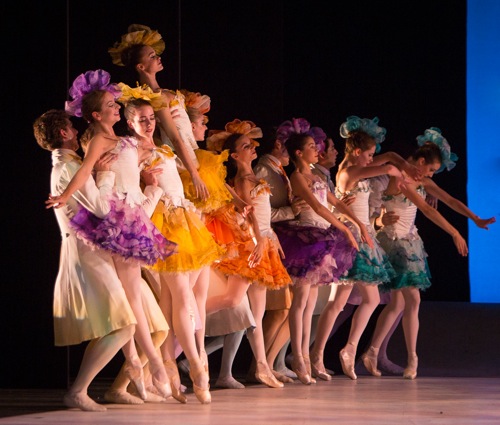
Thank you Deborah; this is the first review of Wheeldon’s Alice that makes me want to see the ballet. I’m quite partial to Toni Pimble’s version for the Eugene Ballet; costumes are based on the original Tenniel illustrations and the choreography for the flamingos in the croquet scene was ever so Petipa. But this looks both interesting and amusing and I suspect the Cheshire cat would be my “best part” as well.
Deborah, I am happy to agree with your enthusiasm about Alice. I attended Sat. eve and enjoyed the ballet immensely. It was Entertainment with a big E! All the dancers were wonderful, especially the tap-dancing Mad Hatter, although I’m not sure which ballerina danced Alice (there was an announcement beforehand which I did not catch)
Miriam